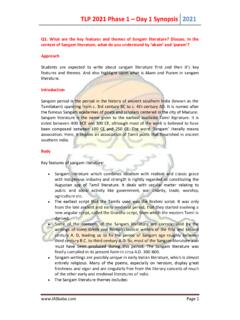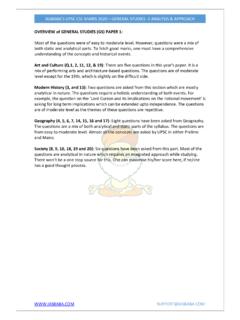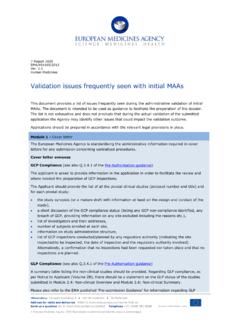Transcription of TLP 2021 Phase 1 Paper 2 final synopsis 2021
1 TLP 2021 Phase 1 paper 2 final synopsis 2021 Page 1 1. What are the socialist principles enshrined in the Indian Constitution? Discuss. Approach A simple and straightforward question where in you need to discuss the socialist principles enshrined in the Indian constitution with some relevant examples from the constitution. Introduction India is a country with second largest population in the world but also it is a developing economy. The only reason of India being developing is unequal distribution of wealth as well as its dual economy character. Socialism becomes important in this background where social and economic equities are to be tackled in fulfilling India s growth story. Body A socialist is someone who supports the political philosophy of socialism, which is governmental system that advocates community ownership and control of all lands and businesses rather than individual ownership. A Constitution is a set of fundamental principles according to which a state is governed.
2 Indian constitution has different set of political philosophies in it. Many leaders of different political orientations took part in drafting this Magna Carta of Socio-economic transformation . The word Socialist , added in the Preamble by 42nd Amendment Act, 1976 indicates the incorporation of the philosophy of socialism which aims to eliminate inequality in income, status and standard of living. By inserting socialist to the preamble of the Constitution of India as a basic structure to the Indian Constitution. The Constitution had a socialist content in the form of certain Directive Principles of State Policy (esp. Arts. 39(b) and 39(c)), even before the term was added in 1976. However, the socialism envisaged by the Indian Constitution is not the usual scheme of State socialism, which involves nationalisation of all means of production, and the abolition of private property. Instead, Indian Socialism is democratic Socialism , influenced by Fabianism.
3 It is a peaceful gradual transformation of the society in participation with the state and not against the state. Though the word Socialism may seem to be vague, our Supreme Court has observed that its principal aim is to eliminate inequality of income and status and standards of life, and to provide a decent standard of life to the working people. In this regard, the socialist principles enshrined in the Indian Constitution can be seen from the following points TLP 2021 Phase 1 paper 2 final synopsis 2021 Page 2 Article 38 - To promote the welfare of the people by securing a social order permeated by social, economic and political justice and to minimise inequalities in income, status, facilities and opportunities. Article 39 - To secure (a) the right to adequate means of livelihood for all citizens; (b) the equitable distribution of material resources of the community for common good; (c) prevention of concentration of wealth and means of production; (d) equal pay for equal work for men and women; (e) preservation of the health and strength of workers and children against forcible abuse.
4 Article 39A - To promote equal justice and to provide free legal aid to the poor. Article 41 - To secure the right to work, to education and to public assistance in cases of unemployment, old age, sickness and disablement. Article 42 - To make provision for just and humane conditions for work and maternity relief. Article 43 - To secure a living wage, a decent standard of life and social and cultural opportunities for all workers. Also, 43A states -To take steps to secure the participation of workers in the management of industries. Article 47 - To raise the level of nutrition and the standard of living of people and to improve public health. The Indian Constitution, therefore, does not seek to abolish private property altogether but seeks to put it under restraints. Instead of a total nationalization of all property and industry, it envisages a mixed economy , but aims at offering equal opportunity to all, and the abolition of vested interests.
5 However, some have argued that the Indian state is deviating from its path of Socialism. The following have been cited as reasons behind this line of argument: The Indian state has failed to end mass poverty where 17% of the population still has incidence of multi-dimensional poverty in 2020. Adoption of neo-liberal economic policy: The new economic policy (1991) of liberalization, privatization and globalization has diluted the socialist credentials of the Indian state. Growth, which happened after the reforms of 1990s exacerbated inter-state and intrastate disparities. Further, this growth has been without any meaningful job creation. Conclusion Though the present conditions demand focus on market economy, socialism cannot be completely abandoned due to India s socio-economic realities and further being a part of basic structure doctrine, it should be upheld as the concept of basic structure as such give s coherence and durability to a Constitution for it has a certain intrinsic force in it.
6 TLP 2021 Phase 1 paper 2 final synopsis 2021 Page 3 2. Discuss the key features adopted in the Indian Constitution from the Government of India Act, 1935. Approach Students are expected to write about the Government of India act 1935. And discuss the important key features of government of India act 1935 adopted in Indian constitution. Introduction The Government of Indian Act was passed by the British parliament in 1935 and came into effect in 1937. It was based on a report by a Joint Select Committee, led by Lord Linlithgow, set up the two houses of the British parliament. The report , in turn, was the result of the Joint Committee s scrutiny of the White Paper a scheme of constitutional proposals - prepared by the British government close on the heels of the Round Table conferences. Body The Act played a key role in the drafting of the Constitution of India, 1950. A significant chunk of the Constitution, particularly the administrative provisions, are borrowed from the Act.
7 Key features adopted in Indian constitution from the Government of India act, 1935: It provided for the establishment of an All-India Federation consisting of provinces and princely states as units. The Act divided the powers between the Centre and units in terms of three lists Federal List (for Centre, with 59 items), Provincial List (for provinces, with 54 items) and the Concurrent List (for both, with 36 items). Residuary powers were given to the Viceroy. Indian constitution took this provision in 7th schedule and placed residuary power in centre. The provinces were allowed to act as autonomous units of administration in their defined spheres. Moreover, the Act introduced responsible governments in provinces, that is, the governor was required to act with the advice of ministers responsible to the provincial legislature. This provision later transferred into state governments power.
8 Thus, the legislatures of Bengal, Bombay, Madras, Bihar, Assam and the United Provinces were made bicameral consisting of a legislative council (upper house) and a legislative assembly (lower house). Six States having a Legislative Council in addition to the Legislative Assembly through Article 169 of the Constitution. It extended franchise. About 10 per cent of the total population got the voting right. Article 326 in The Constitution of India 1949. Elections to the House of the People and to the Legislative Assemblies of States to be on the basis of adult suffrage the elections to the House of the People and to the Legislative Assembly of every State shall be on the basis of adult suffrage. TLP 2021 Phase 1 paper 2 final synopsis 2021 Page 4 It provided for the establishment of not only a Federal Public Service Commission but also a Provincial Public Service Commission and Joint Public Service Commission for two or more provinces.
9 Articles 315 to 323 of Part XIV of the constitution, titled as Services Under the Union and the States, provide for a Public Service Commission for the Union and for each state. This was adopted from the government of India Act 1935. It provided for the establishment of a Federal Court, which was set up in 1937. India s Supreme Court succeeded the Federal Court of India on 28 January, 1950 which was established by the Government of India Act 1935 and the Privy Council, which was the highest judicial body in the country during British era. Conclusion The 1935 Act was aimed to perpetuate British rule and design to appease Nationalists. The act also had regressive provisions such as separate electorate and had divide and rule as it s guiding philosophy. GOI Act, 1935 reduced the time frames of constitution creation, we should not forget that it was created to manage (or control) the affairs of a colony upon vested commercial interests of The Great Britain.
10 At the same time, we need to accept that there were many Indian intellectuals laid a strong foundation well before GOI Act, 1935 for this cause. 3. What are the socialist principles enshrined in the Indian Constitution? Discuss. Approach A simple and straightforward question where in you need to discuss the socialist principles enshrined in the Indian constitution with some relevant examples from the constitution. Introduction India is a country with second largest population in the world but also it is a developing economy. The only reason of India being developing is unequal distribution of wealth as well as its dual economy character. Socialism becomes important in this background where social and economic equities are to be tackled in fulfilling India s growth story. Body A socialist is someone who supports the political philosophy of socialism, which is governmental system that advocates community ownership and control of all lands and businesses rather than individual ownership.

















